
The Golden Gate before the Bridge - 1932 © Ansel Adams / 2015 The Ansel Adams Publishing Rights Trust
Expositions du 10/7/2015 au 8/9/2015 Terminé
Quintenz Gallery 613 E Cooper Ave, Suite 108 CO 81611 Aspen États-Unis
“Wilderness, or wildness, is a mystique. A religion, an intense philosophy, a dream of ideal society—these are also mystiques. As the fisherman depends upon the river, lakes and seas, and the farmer upon the land for his existence, so does mankind … depend upon the beauty of the world about him for his spiritual and emotional existence.” -- Ansel Adams, from a speech to The Wilderness Society, May 9, 1980Quintenz Gallery 613 E Cooper Ave, Suite 108 CO 81611 Aspen États-Unis
Aspen, CO – Spanning seven decades of his groundbreaking career, a major retrospective of more than 50 photographs by Ansel Adams will be on view from July 10–September 8, 2015, at the Quintenz Gallery in Aspen, Colorado. Ansel Adams: Masterworks from Seven Decades, 1928–1982 comprises the entirety of one of the most significant, privately held Adams collections. Most of the work has not been exhibited in many years. The exhibition is presented in association with Michael Shapiro Photographs, Westport, CT.
Ansel Adams (American 1902–1984) is widely recognized for his portrayal of the sublime in America’s wilderness. Yosemite National Park captured his imagination during his first visit at age 14. He later wrote, “That first impression of the valley—white water, azaleas, cool firm caverns, tall pines and stolid oaks, cliffs rising to undreamed of heights, the poignant sounds and smells of the Sierra ... was a culmination of experience so intense as to be almost painful.”
Among the highlights in the exhibition are singular examples of many of Adams’s most famous images from Yosemite including Clearing Winter Storm, Yosemite National Park, circa 1937. The photograph was the cover image of his famous 1982 book Yosemite and the Range of Light, and the print in the exhibition is one of the earliest enlargements of the work. Moon and Half Dome, Yosemite National Park, 1960, is a rare oversized print of a remarkable landscape made close to the time of the negative.
The exhibition features an important print of one of Adams’s most famous images, Moonrise, Hernandez, New Mexico, 1941. This print was made in the early 1960s when photographic paper companies used more silver in their paper. By comparison, prints of the work made in the 1970s have a different tone as the costly silver content was gradually removed from the paper. Adams also noted the changes in printing by various negatives: “The negative is comparable to the composer's score and the print to its performance. Each performance differs in subtle ways.”
One of the most significant photographs in the exhibition is a print of Rose and Driftwood, 1932, an iconic image of a rose in full bloom. The print was recently discovered to have been exhibited in Adams’s very first New York show at Delphic Studios in 1933.

Moon and Half Dome, Yosemite National Park, California - 1960
Photograph by Ansel Adams
© 2015 The Ansel Adams Publishing Rights Trust
Also included are unique photographs that are most likely the only surviving evidence of their negatives. They include a large-scale print from the 1960s, Mount Dana, Tioga Lake, Yosemite National Park and a 1930s print of El Capitan, Yosemite National Park that was sold when Adams and his wife Virginia moved to Yosemite around 1937, where they lived for a number of years.
Ansel Adams: Masterworks from Seven Decades, 1928–1982 is the most important retrospective of Adams’s work since the seminal exhibition Ansel Adams at 100 organized in 2001 by the Museum of Modern Art, New York, and the San Francisco Museum of Modern Art. Like the MoMA exhibition, Ansel Adams: Masterworks from Seven Decades, 1928–1982 includes superb vintage prints made at the height of Adams’s darkroom abilities.
The photographs in Ansel Adams: Masterworks from Seven Decades, 1928–1982 come from a private Florida-based collector who, over a period of 27 years between 1975 and 2002, collected some of the most significant work produced by Adams. The broader collection focused on Group f/64, the most influential West Coast photographic organization of its time, founded in the early 1930s. The eleven members, including Adams, Edward Weston, and Imogen Cunningham, were the most significant contributors to Northern Californian avant-garde photography.
Adams’s early experiences in nature shaped his life’s work and his purpose as an advocate for the preservation of the American wilderness. While on a family vacation in 1916, and with his first camera, Adams made his earliest photographs of Yosemite National Park. He spent countless hours and days there throughout the rest of his life as a source of inspiration and strength. Public recognition of Adams’s work led to his first publication in 1927, a photographic portfolio entitled Parmelian Prints of the High Sierras.
A decided environmentalist at the forefront of the movement, Adams was awarded a commission by the U. S. Department of the Interior in 1941. “The Mural Project” was an extensive document of the American national parks system designed to decorate the department’s new offices in Washington, D. C. This began Adams’s first experiments with large-scale printing.
Adams was a photographer’s photographer. Without dispute, no one contributed more to the science of 20th-century American photography. Adams published his first technical book, Making a Photograph, in 1935. Between 1939 and 1941, he created a technical process—the Zone System—that revolutionized the making of negatives and photographic prints, widely accepted as the standard for black and white photography to this day.


